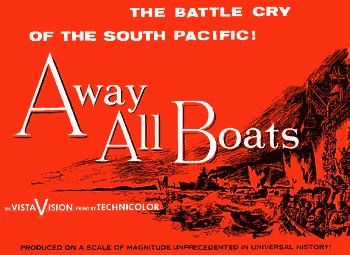|
|
|
|
|
|
|
|
|
|
|
|

The Story of a Patriot, a short film produced for Colonial Williamsburg in Virginia, was photographed in VistaVision. It is unique in that the 8 perforation horizontal print is made on CinemaScope perforated stock and carries a six channel sound track. Information on the Colonial Williamsburg theatre is provided in the VistaVision section of the Reference Library, (back to the Lobby and select the library icon). That's patriotic Jack Lord featured in the faux color corrected frame above. "Book 'em, Danno".
STORY OF A PATRIOT footage provided by Chester T. Hartwell
 |  |
Contrary to Paramount's claims to theatre chains, other major studios didn't race to produce films in VistaVision. Seen here are three rare examples of films done by MGM, Universal, and independent producer Stanley Kramer in the Lazy 8 system. One of VistaVision's drawbacks, which was really a virtue, was that it required Technicolor dye transfer prints, which cost the cheapskate studios a few more dollars than their own wretched in house labs.  | |
Alfred Hitchcock probably possessed one of the keenest visual senses of any of the screen's truly great film directors. He was under contract with Paramount during the heyday of the widescreen revolution and wholeheartedly embraced the image capabilities of VistaVision. He used the process on every one of his Technicolor productions during the period that VistaVision was used as a full production process, including his splendid epic North by Northwest which he did at Metro-Goldwyn-Mayer. Here are presented a series of photos of Lord Alfred shooting with VistaVision units. He used an ensemble crew on the majority of his films in the 1950's and 1960's, including Oscar winning cinematographer Robert Burks, ASC.

Hitchcock directs Edmund Gwen and Mildred Natwick in his second VistaVision film, The Trouble With Harry. The camera is one of the Technicolor conversions in its refrigerator size sound blimp. You will note the similarity to the camera shown filming The Big Country illustrated in the Technirama wing of the museum. The slanted top front of the blimp indicates that the camera inside is using the 2,000 foot coaxial film magazine necessary for running the camera at a speed of 180 feet per minute. The original cameras, as set up for Technicolor photography, used three 1,000 foot reels of film in a more conventional looking Mickey Mouse ear magazine.
Putting another picture of Grace Kelly in this web page was just too tempting.
The film is Hitchcock's first VistaVision feature, To Catch A Thief. This real life Cinderella appeared in normal black & white as well as color 3-D, VistaVision, and CinemaScope films in her all too brief career. I'm told that Cary Grant is also in this photo.
OOPS! It happened again. Thelma Ritter probably made more VistaVision films than Grace Kelly, but is that the way we want to remember Paramount's high definition photographic system?
Now back to our program.
Damn! This is getting out of hand. Okay, here's the last picture of Grace. My, my, isn't it obvious why she was such a sensation? Imagine that face belonging to a very accomplished actress? In her royal life, she exhibited her regal nature to good effect, and worked tirelessly for the betterment of the human condition.
Selected images of Grace Kelly have been stolen from the Paramount Home Video DVD release of To Catch A Thief. The curator recommends this to one and all.
Alfred Hitchcock's relationship with VistaVision continues on the next page. You are on Page 3 of






Read the complete text of the VistaVision article written for
WideGauge Film and Video Monthly
E-mail the author
CLICK HERE©1996 - 2004 The American WideScreen Museum
http://www.widescreenmuseum.com
Martin Hart, Curator



